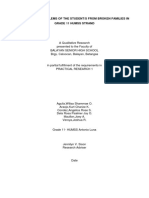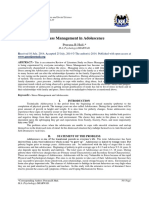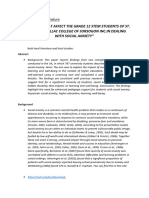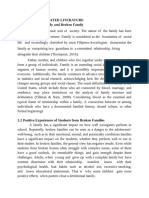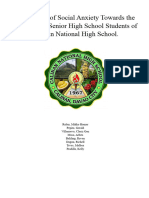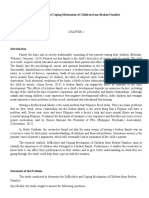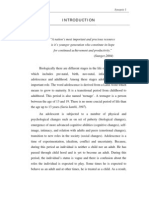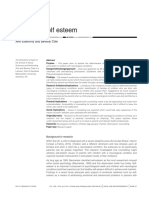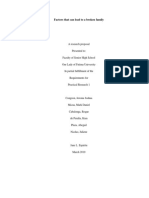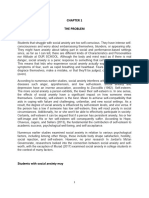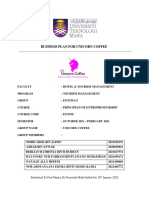Professional Documents
Culture Documents
A Search of Different Maladjusted Behavi PDF
Uploaded by
Durriya AnisOriginal Title
Copyright
Available Formats
Share this document
Did you find this document useful?
Is this content inappropriate?
Report this DocumentCopyright:
Available Formats
A Search of Different Maladjusted Behavi PDF
Uploaded by
Durriya AnisCopyright:
Available Formats
International Journal of Research in Social Sciences
Vol. 6 Issue 9, September 2016,
ISSN: 2249-2496 Impact Factor: 6.278
Journal Homepage: http://www.ijmra.us, Email: editorijmie@gmail.com
Double-Blind Peer Reviewed Refereed Open Access International Journal - Included in the International Serial
Directories Indexed & Listed at: Ulrich's Periodicals Directory ©, U.S.A., Open J-Gage as well as in Cabell‟s
Directories of Publishing Opportunities, U.S.A
A SEARCH OF DIFFERENT MALADJUSTED
BEHAVIOURS OF ADOLESCENTS INSIDE AND OUTSIDE
OF CLASSROOM AND THE CAUSAL FACTORS THAT
ARE RESPONSIBLE FOR THEIR BEHAVIOURS
Raju Singha*
Arindam Bhattacharjee**
ABSTRACT
Education plays very important role in making the man well adjusted in the society . Education
in real sense , is to humanize humanity and to make life progressive , cultured and civilized .
Everyone want to adjust himself with his environment . The modern education has these
objectives . But it is also true that every individual do not have the same potentialities to adjust
himself and now a days it is a major problem in our educational institution as well as in our
society . The study was conducted with 50 male and female students among the secondary level .
For this study a general information schedule , questionnaire and a checklist was formed . The
study highlighted the common behavioural problems among the students . It has been found from
the study that female students and male students have the different maladjustment problems .
The study will provide the knowledge about the different types of maladjustment and their
relative causes among secondary level students . It will be helpful for the teacher to understand
and overcome different related problems .
Keywords : adjustment , secondary level , maladjustment .
*
Assistant Teacher , Khutadaha R.C high school (H.S)
**
Assistant Professor , malda Govt. Teachers’ Training college
Vol. 6 Issue 9, September 2016
436 Journal Homepage: http://www.ijmra.us, Email: editorijmie@gmail.com ISSN: 2249-2496
1. INTRODUCTION
Adjustment is the process by which a living organism maintains a balance between its needs and
the circumstances that influence the satisfaction of these needs . Individuals adjustment is
adequate . wholesome or healthy to the extent that he has established harmonious relationship
between the person and his environment . Contrary to adjustment , maladjustment represents a
condition or a state in which one feels that one‟s need are not fulfilled and he has been a failure
in establishing harmony with his self and the environment.
„maladjustment‟ is defined as the inability to react Successfully and satisfactorily to the
demands of one‟s environment . According to the American Heritage Stedman‟s Medical
Dictionary , (2002) , Though the term applied a wide range of biological , social and
psychological conditions , it often implies an individuals‟ failure to meet social or cultural
expectations.
Collins‟ English Dictionary define maladjustment as a failure to meet the demands of the society
, coping with problems and social relationships ; usually reflected in emotional instability .
According to Cambridge Dictionary “ A maladjusted person , usually a child has been raised in a
way that does not prepare them well for the demands of life , which often leads to problems
behaviours in future.‟‟ This maladjustment is a condition related to social and personal
difficulties in various areas like personal relationships , problem solving , emotional stability ,
need fulfilment etc.
In psychology , the term refers to unsatisfactory behaviour patterns that cause anxiety and
require psychotherapy . This maladjustment is a process whereby an individual is unable to
satisfy his biological , psychological or social needs successfully and establishes an imbalance
between his personal needs and expectations of the society resulting inb the disturbance of
psycho equilibrium . (Mangal , 1995)
In the words of Herbart Sorenson “ A person is not in harmony with his work if it is too hard or
if the student has too hard or if the student has too little capacity excessive failure is experienced
if it is too easy or if the student has too high ability for his work , the work is dull and dreaming.”
Vol. 6 Issue 9, September 2016
437 Journal Homepage: http://www.ijmra.us, Email: editorijmie@gmail.com ISSN: 2249-2496
SYMPTOMS OF MALADJUSTMENT
The committee on maladjusted children (UK) headed by J. E. A. Underwood , in its report in
1955 listed the following problems ;
Nervous disorders :
Fears – anxiety , Phobia , timidity , oversensitivity. With drawl – unsociability , solitariness .
Depression – brooding , melancholy periods . Apathy – leathargy , unresponsiveness , no
interests . Obsessions – rituals and compulsions .
Habit Disorders :
Speech – stammering, speech defects . Movements – twitching, rocking, head banging , nail
biting . Excretion – it continuance of urine and faces. Nervous pain and paralysis – headache.
physical symptoms – asthma and other allergic conditions .
Behaviour Disorders :
Unmanageable – defiance , disobedience , refusal to go to school or work . Aggressiveness –
bulling , destructiveness , cruelty . Behaviour – jealous , demands for attention , begging and
stealing , lying and romancing . Truancy – wondering , staying out late . Sex difficulties –
masturbation , sex play , homosexuality .
Organic Disorders :
Conditions following head injuries , encephalitis or central tumors , epilepsy .
Psychotic Behaviours :
Hallucinations , delusions , extreme with drawl , violence .
Educational and Vocational difficulties :
Backwardness not accounted for by dullness , unusual response to school discipline , inability to
concentrate .
Vol. 6 Issue 9, September 2016
438 Journal Homepage: http://www.ijmra.us, Email: editorijmie@gmail.com ISSN: 2249-2496
CAUSES OF MALADJUSTMENT :
The main causes of maladjustment behaviour of adolescence are as follows :
Family :
According to David Magnusson (1983) , The family is an institution has various functions to
perform various causes e.g. social , economic and psychological contribute immensely to
maladjustment or maladjusted behaviour . In multiple studies , it has been found that support
from parents bonds the adolescent to institutions and builds their self control (Barnes et al.,
2006) Many studies have demonstrated that lack of parental monitoring and non – involvement
serves as one of the most robust predictors in youth‟s delinquent behaviour (Barnes et al., 2006)
Holden‟s (2006) findings that parental inadequacy , absence or destructiveness interrupt and
damage a child‟s normal maturation process . This illustrates how important parents are in a
child‟s life and how their involvement can make a difference in shaping the behaviour of their
childrens .
Social causes :
Gibson (1953) , has found in his study that the social problems of one generations is the
psychological problems of the next generation . Children coming from homes that have been
broken due to death , divorce , separation etc . one often causes maladjustment in student
behaviour . According to Maseko (2009) , children who are born and grow up in a good social
environment will have conditions to improve qualities and personalities . On the contrary , if
they live in a complex social environment , abounded with social evils , they will certainly be
affected in their personality development .
Psychological Causes :
If parents are over possessive , highly authoritative , unrealistic in their expectations ,
incompatible and abusive , this will have been in adverse effect upon their children . When the
psychological needs are not met , students get frustrated and develop problems like nail biting ,
fear of darkness , lack of self-confidence . Individuals who display large emotional variability
over time are characterized by higher levels of depression , nuroticism and low self-esteem (Eid
Vol. 6 Issue 9, September 2016
439 Journal Homepage: http://www.ijmra.us, Email: editorijmie@gmail.com ISSN: 2249-2496
& Diener , 1999). Research has shown that indicators of low psychological well-being , such as
nuroticism and low self-esteem are related to impairments in affect repair (Wood , Marshal &
Brown , 2003) and evidence suggest that depression , for inctance , is characterized by longer
duration of negative moods and emotional states once initiated (Allen , Davis & Sorenson ,
2000).
Personal Causes :
The individual who are physically , mentally , visually handicapped react in their own way .
Sometime they become maladjusted due to situation which is not easy to them . The student who
are not able to score well academically compares to their peers , they develop an inferiority
complex and finally they isolate themselves from others and indulge in day dreaming . A child
exhibiting mal adaptive behaviours may have health problem which interfere with his proper
adjustment to classroom situation . As example ; a child who is inattentive in class may be
struggling with a perceived attack of asthma or epilepsy (Ogbue , Obani & Abori , 1987).
Peer pressure :
Another important factor is that disturbs the psy equilibrium of students in the unhealthy
relationship with peer and their influences on different unsocial activities . Sanders , (2005) &
Sulivan , (2006) who has found peer-pressure to be the strongest predictor of delinquency
compared to family factors and childhood emotional and behavioural problems
School related causes :
When growing children do not find ways and means to channelize their energy in a purposeful
manner in the school , they easily exist in maladjusted behaviour . The main school related
causes behind maladjustment behaviour among students are excessive and hard disciplines ,
defective curriculum , faulty teaching method , lack of recreational time , the authoritarian role of
teachers etc.
2.REVIEW OF LITERATURE :
Kocher derfer , B . J . , & Ladd , G . W . (1996) . peer victimization : cause or consequence of
school maladjustment ? child development.
Vol. 6 Issue 9, September 2016
440 Journal Homepage: http://www.ijmra.us, Email: editorijmie@gmail.com ISSN: 2249-2496
Tyagi , (1985) , pointed out that emotional maturity was positively correlated to personal , social
and overall adjustment and female subjects scored higher on emotional maturity .
Mutekwe , E . , & Mutekwe , C . (2013) . Teachers‟ perceptions of pupil maladjustment
problems : A psychosocial perspective .
Angeline , Dollias & Mech , (1956) , noted a constant increase in fears and worries by girls in
activities involving social relations . This fear was less pronounced in boys . In both adolescents
(boys & girls) there are increases in fear after age fifteen especially in the economic and political
areas .
Miranda , M . C . , Affuso , G . , Esposito , C . , & Bachhini , D . (2016) . Parental acceptance –
Rejection and adolescent maladjustment : Mother‟s and father‟s combind roles . Journal of child
and family studies .
Bhagia , (1966) , in his study found that girls exceed boys significantly in their adjustment to
general environment and organizational aspect of the school .
Dutta , (1979) , investigated the effects of malnourishment on self concept , personal , social
adjustment and cognitive competence of boys coming from low income families .
Weymouth , B .B . , Buechler , C . , Zhou , N . , & Henson , R . A . (2016) . A meta analysis of
parent-adolescent conflict . Disagreement , Hostility and youth maladjustment . Journal of family
theory & review.
Sunita , (1986) , found that girl‟s were better adjusted at home than boys . Boys were more
socially adjusted than girls . Boys were more emotionally adjusted than girls .
Chopra . R & Kalita . R , (2006) , found that the emotional , social and educational adjustments
of elementary school children of single parents have several problems rather than intact families
and affect their development .
Vol. 6 Issue 9, September 2016
441 Journal Homepage: http://www.ijmra.us, Email: editorijmie@gmail.com ISSN: 2249-2496
3. OBJECTIVES :
The general objectives of the study was to establish the factors that contribute maladjusted
behaviour among the adolescent students of higher secondary level .
The aims of the study was to identify the pattern of maladjustment among the students of middle
childhood to adolescence . This study also emphasized of the causal description of pattern of
maladjustment and how these evolve maladjustment .
The study highlighted about the causal relationship between various forms of maladjustment and
its causal factor among the adolescence students .
4. TARGET AREA :
To achieve the objective a number of 50 students (N=50) (Male : 25 , Female : 25) were selected
from bamongola block of Malda district , W.B through random sampling method . 50 students
bond suitable for the purpose . The student participated in this study were teenager and their
average age was 13-15 years . The distribution of the sex ratio on the study Male : Female were 1
: 1 . Students were cooperative and able to understand the questions which were asked to them.
5. METHODOLOGY :
To achieve the above mentioned objectives , the investigator address it in two fold steps :
A. Identification of the maladjusted students through behavioural checklist.
B. Identification of the causes of maladjusted behaviour through questionnaire.
To identified maladjusted behaviour , a list of maladjusted behaviours were prepared which was
collected from different review based articles , and through interview with student , parents and
teachers . The listed behaviours were simplified into statement form and it was framed in two
point dichotomous scale („YES‟ OR „NO‟). Judgements about the students made by teacher‟s or
parents . The behaviour checklist was further utilized to understand the nature of problem
associated with the causes of maladjustment traits , social , emotional and academic .
After identification of the problem , the second objectives of the study was in consideration .
After classification of the broad dimensions related with causal factors of maladjustment 45
Vol. 6 Issue 9, September 2016
442 Journal Homepage: http://www.ijmra.us, Email: editorijmie@gmail.com ISSN: 2249-2496
statements were prepared as questionnaire for final data collection . The social , emotional and
academic causes were frame on questionnaire structure . Then it has produced to 50 selected
students for data collection . The students were further interviewed through the questionnaire and
data were collected accordingly.
6. RESULT AND DISCUSSION
Table 1 : Major causes of maladjustment (Female)
Total no. Of students Related causes No. Of percentage
12 Shyness (Emotional) 48%
3 Parental rejection (Social) 12%
4 Low family income (social) 16%
2 Peer pressure (Social ) 8%
4 Fear (Emotional) 16%
25 100%
Table 2 : Major causes of maladjustment (Male)
Total no. Of students Related causes No. Of percentage
11 Peer pressure (Social) 44%
5 Broken home (Social ) 20%
4 16%
Low family income (Social)
2 8%
Vol. 6 Issue 9, September 2016
443 Journal Homepage: http://www.ijmra.us, Email: editorijmie@gmail.com ISSN: 2249-2496
Fear (Emotional )
3 6%
Shyness (Emotional)
25 100%
The study was conducted to find out nature of maladjustment and the causes of maladjustment
among the students in secondary level . To achieve the purpose , a general information schedule ,
a behavioural checklist and a questionnaire was prepared to find out the causes of maladjustment
. 50 students with average age 13-15 in class x-xii from different socio-economic group was
selected through the screening by behaviour checklist . The study highlighted the common
behavioural problems among the students including aggression , lack of confidence , nervousness
, lying , truancy , disobedience etc. The study followed that shyness , fearfulness , peer pressure
are the maximum rated behavioural problems . Apart from that stealing , inferiority , easily
discouraged , delinquent tendencies etc. Also rated as maladjusted problems . It has been found
from the study that maximum number of female students rated for shyness (48%) , emotional
cause of maladjustment behaviour and for male students the maximum rated cause is peer
pressure (44%) , social cause . It is enough to conclude that female student has less control on
their emotion than male students and male students have more effect of social cause rather than
female students for their maladjusted behaviours .
The overall score from the questionnaire exhibited intermediate nature of causes for problems
related with maladjustment behaviour . But dimension wise the study revealed various kind of
causes included .
REFFERENCE :
1. Allen & Collins , W . A . (1990) . Parent-child relationships in the transition to adolescence :
continuity and change in interaction , affect and cognition . In Raymond Montemayor , Gerald
Adams and Thomas Gullotta eds . , From childhood to adolescence : A transitional period ?
Beverly Hills , CA : Sage , 1990.
2. Kaul , Lokesh (2005) . Methodology of educational research . Vikash Publishing House , New
Delhi.
Vol. 6 Issue 9, September 2016
444 Journal Homepage: http://www.ijmra.us, Email: editorijmie@gmail.com ISSN: 2249-2496
3. Pandey , J . (1968) . Adjustment problems of Adolescents in relation to their personality
variables. Ph.D Thesis , Varanasi , B.H.U.
4. Sharma , H. L. (2005) . Study of adjustment among institutionalized delinquents in relation to
their types disabilities and impairements . Indian Educational Abstracts Vol . 19 (1) pp. 23-29.
5. Beal , Sarah . J . & Crocket , Lisa J. , “ Adolescents‟ occupational and educational aspirations
and expectations : Links to high school activities (2010) . Faculty Publications . Department of
Psychology.
6. Goswami , N . (1980) . Adjustment problems of school going adolescents girls. New Delhi :
NCERT.
7. Crow , L . D . and Crow , A . C . (1956) . Adolescence development and adjustment . New
York : Mc Graw Hill Book co.
8. Bhatt , K . K . (1971) . Adjustment problems of the under achievers , university school of
psychology , Gujarat university .
9. Sujatha , S . , Gaonkar , V . , Khadi , P. & Katarki , P . A . (1993) . Factors influencing
adjustment among adolescents . Indian psychological review .
10. Bhatt , L . J . , Patel , P . M . Patel , M . M . and Parikh , D . S . (1961) . Inquiry into
psychological factors related to adolescent adjustment . ICMR project , Faculty of education
psychology , M . S . U . (ICMR-Finance).
Vol. 6 Issue 9, September 2016
You might also like
- Qualitative Research SampleDocument22 pagesQualitative Research Samplenovee mae95% (20)
- Role: Plaintiff (P1)Document21 pagesRole: Plaintiff (P1)Indrani Maity0% (2)
- A Review of The Resilience Scale: Gail Wagnild, RN, PHDDocument9 pagesA Review of The Resilience Scale: Gail Wagnild, RN, PHDcarainNo ratings yet
- Research Paper (PR 1)Document18 pagesResearch Paper (PR 1)KC100% (6)
- A level Psychology Revision: Cheeky Revision ShortcutsFrom EverandA level Psychology Revision: Cheeky Revision ShortcutsRating: 5 out of 5 stars5/5 (1)
- Bernard, M. E. - The Social and Emotional Wellbeing of Students Who Bully Different StrokesDocument43 pagesBernard, M. E. - The Social and Emotional Wellbeing of Students Who Bully Different StrokesMonica Ciurea100% (1)
- (Psychological Disorders) Vatsal Thakkar, Pat Levitt - Depression and Bipolar Disorder-Chelsea House Publications (2006) PDFDocument111 pages(Psychological Disorders) Vatsal Thakkar, Pat Levitt - Depression and Bipolar Disorder-Chelsea House Publications (2006) PDFUrsache BogdanNo ratings yet
- Astrology:Bach FlowersDocument6 pagesAstrology:Bach FlowersJoseph Cannillo90% (10)
- Advanced Empathy TrainingDocument8 pagesAdvanced Empathy TrainingNonna Agata100% (2)
- Parent-Child Interaction Therapy: A Literature Review On Its Effectiveness For Children With Autism S...Document26 pagesParent-Child Interaction Therapy: A Literature Review On Its Effectiveness For Children With Autism S...KINo ratings yet
- Effects of Dysfunctional FamiliesDocument10 pagesEffects of Dysfunctional FamiliesemeraldNo ratings yet
- DRAFTDocument6 pagesDRAFTEarl Steven FloresNo ratings yet
- Literacy and Mental Health (Updated 2018)Document14 pagesLiteracy and Mental Health (Updated 2018)mielcalamaNo ratings yet
- Chapter 1: The Problem and Its Background IntroductionDocument17 pagesChapter 1: The Problem and Its Background IntroductionChristian VillaNo ratings yet
- Stress Management in Adolescence: Prerana.R.Huli.Document8 pagesStress Management in Adolescence: Prerana.R.Huli.Nicole AphroditesNo ratings yet
- Local Literature and Local StudiesDocument2 pagesLocal Literature and Local StudiesRaizel RebustilloNo ratings yet
- About Social Anxiety and SchoolsDocument9 pagesAbout Social Anxiety and SchoolsLOIS ANNE RAZONNo ratings yet
- Low Self - Esteem Chapter IDocument10 pagesLow Self - Esteem Chapter ILeun100% (3)
- Chapter 2Document3 pagesChapter 2Ricky CabaloNo ratings yet
- LX20221116 461Document11 pagesLX20221116 461Abdullah AkhtarNo ratings yet
- PriveDocument16 pagesPriveayel crossNo ratings yet
- 03 AbstractDocument9 pages03 AbstractramuanuNo ratings yet
- Bullying and The Cost of Mistreatment (Excerpt From Safe School Ambassadors)Document10 pagesBullying and The Cost of Mistreatment (Excerpt From Safe School Ambassadors)Jossey-Bass EducationNo ratings yet
- Research Literature ReviewDocument3 pagesResearch Literature ReviewNica JuanNo ratings yet
- The Effects of Social Anxiety Towards The Behavior of Senior High School Students of Calinan National High SchoolDocument12 pagesThe Effects of Social Anxiety Towards The Behavior of Senior High School Students of Calinan National High SchoolIsmurpp NikentNo ratings yet
- CSP 500 Resilience Paper DraftpdfDocument24 pagesCSP 500 Resilience Paper Draftpdfapi-741762310No ratings yet
- Pr2 ReviseDocument9 pagesPr2 ReviseRommel Castro SarenasNo ratings yet
- Final Research ProposalDocument14 pagesFinal Research Proposalapi-309943573100% (1)
- Difficulties and Coping Mechanism of Children From Broken FamiliesDocument4 pagesDifficulties and Coping Mechanism of Children From Broken FamiliesMary Ann Tecson100% (3)
- Bullying Thesis For A Research PaperDocument5 pagesBullying Thesis For A Research Paperrachelwaltersannarbor100% (1)
- Social Anxiety ResearchDocument21 pagesSocial Anxiety ResearchJohn DoroteoNo ratings yet
- Study On The Relationship Between Frustration Behavioral Problems Among Adolescent Students in KolDocument21 pagesStudy On The Relationship Between Frustration Behavioral Problems Among Adolescent Students in Kolnallarasu7477No ratings yet
- Spe 111 BehaviorDocument3 pagesSpe 111 BehaviorBenjamin BandaNo ratings yet
- Cycles of Self EsteemDocument11 pagesCycles of Self EsteemAndini Pritania PutriNo ratings yet
- All in One For FINALDocument107 pagesAll in One For FINALAshirt ValdescoNo ratings yet
- Chapter 1Document12 pagesChapter 1Chen ChenNo ratings yet
- Peros SincerityDocument20 pagesPeros SincerityNoel Velasco SaweNo ratings yet
- Assessment: Group Camacho-Ignacio (Salcedo) "Unspeakable Mental Health of INNHS Grade 12 Students Within Their Families: A Qualitative Research"Document3 pagesAssessment: Group Camacho-Ignacio (Salcedo) "Unspeakable Mental Health of INNHS Grade 12 Students Within Their Families: A Qualitative Research"John Rotrix TumanengNo ratings yet
- DivorceDocument30 pagesDivorceJessa B. Regalario75% (4)
- RESEARCHDocument31 pagesRESEARCHPaopao MacalaladNo ratings yet
- O24.22.02. Family Well Being and Disabled Children A Psychosocial Model ofDocument13 pagesO24.22.02. Family Well Being and Disabled Children A Psychosocial Model ofLukas LeNo ratings yet
- Disruptive Behavior Disorders NotesDocument14 pagesDisruptive Behavior Disorders NotesAngela RegalaNo ratings yet
- OmskrtDocument3 pagesOmskrtmayangNo ratings yet
- Parent Child Attachment and Problem Behavior Reporting by Mothers With Pathology in Different Socioeconomic StatusDocument12 pagesParent Child Attachment and Problem Behavior Reporting by Mothers With Pathology in Different Socioeconomic StatusSudiptiNo ratings yet
- Thesis Title About Social BehaviorDocument5 pagesThesis Title About Social Behaviorsamantharossomaha100% (2)
- Research Defended Cutie RevisedDocument20 pagesResearch Defended Cutie RevisedmargaNo ratings yet
- Chapter 2Document10 pagesChapter 2regalajeirson34No ratings yet
- Cook Et Al. Literature - Review - Oppositional - Defiant - DDocument11 pagesCook Et Al. Literature - Review - Oppositional - Defiant - DbooksrgoodNo ratings yet
- Essay 3 Final DraftDocument7 pagesEssay 3 Final Draftapi-581791742No ratings yet
- Ej 1162075 LDDocument10 pagesEj 1162075 LDapi-549604532No ratings yet
- Summaries of ArticlesDocument6 pagesSummaries of ArticlesMemoona NawazNo ratings yet
- Broken FamilyDocument15 pagesBroken FamilyGabriel VillaveraNo ratings yet
- Ms. Muqaddas ButtDocument6 pagesMs. Muqaddas ButtShaNo ratings yet
- Rheagwapa Final ResearchDocument43 pagesRheagwapa Final ResearchJullier E. RuizNo ratings yet
- Impact of A Broken Family To School Aged ChildrenDocument10 pagesImpact of A Broken Family To School Aged ChildrenCourtney Dela Pena100% (2)
- ReportDocument32 pagesReportNambwere SaidatNo ratings yet
- Research 1 2 3Document20 pagesResearch 1 2 3Julito Paler Tubal Jr.No ratings yet
- Cause and Effect Essay FinalDocument5 pagesCause and Effect Essay FinalAlteaNo ratings yet
- 12 - IRSSH With Cover Page v2Document10 pages12 - IRSSH With Cover Page v2Angela FredasNo ratings yet
- Role of Family in The Development of Social Competence and Emotional Resilience Among Children With Learning DisabilitiesDocument11 pagesRole of Family in The Development of Social Competence and Emotional Resilience Among Children With Learning DisabilitiesAnonymous CwJeBCAXpNo ratings yet
- FRAMEWORKDocument2 pagesFRAMEWORKSuzine TorrenuevaNo ratings yet
- BUKASDocument13 pagesBUKASDexene caguladaNo ratings yet
- Role of Parents in The Educational Development of Mentally Retarded LearnersDocument7 pagesRole of Parents in The Educational Development of Mentally Retarded LearnersAnonymous CwJeBCAXpNo ratings yet
- Term 7Document23 pagesTerm 7Mark Angelou OritNo ratings yet
- Fibromyalgia: by AdamDocument17 pagesFibromyalgia: by AdamMioara HorbaniucNo ratings yet
- Project 1 Expanded Middle New Research 1Document4 pagesProject 1 Expanded Middle New Research 1api-595118101No ratings yet
- The Mentally Ill Physician - Issues in Assessment, Treatment and AdvocacyDocument15 pagesThe Mentally Ill Physician - Issues in Assessment, Treatment and AdvocacyNatalia MartínezNo ratings yet
- Introduction To Flower Essence Therapy: Dr. Orna Izakson, ND, RH (AHG)Document42 pagesIntroduction To Flower Essence Therapy: Dr. Orna Izakson, ND, RH (AHG)Alma Gabriela Valenzuela FloresNo ratings yet
- Union Test Prep Nclex Study GuideDocument115 pagesUnion Test Prep Nclex Study GuideBradburn Nursing100% (2)
- Katschnig TRIPS-2 - Interview English PDFDocument12 pagesKatschnig TRIPS-2 - Interview English PDFJana ChihaiNo ratings yet
- Determinant Factors of Depression A Survey Among University StudentsDocument7 pagesDeterminant Factors of Depression A Survey Among University StudentsenunzNo ratings yet
- The Effectiveness of Mindfulness Based Programs In.4Document9 pagesThe Effectiveness of Mindfulness Based Programs In.4Begoña MartinezNo ratings yet
- Data Diabetes Kota MakassarDocument7 pagesData Diabetes Kota MakassarKabul BudionoNo ratings yet
- Writing The First Chapter: Practical Research 1Document2 pagesWriting The First Chapter: Practical Research 1Jep Jep PanghulanNo ratings yet
- MMPI-2 Adult Interpretive System Version 4 Codetype ReportDocument29 pagesMMPI-2 Adult Interpretive System Version 4 Codetype ReportbalroqNo ratings yet
- Increasing Suicide Tendency in StudentDocument6 pagesIncreasing Suicide Tendency in StudentabhiharshNo ratings yet
- Prevalence of Depression, Anxiety and Stress and Its Association With Workplace Satisfaction in Medical College TeachersDocument8 pagesPrevalence of Depression, Anxiety and Stress and Its Association With Workplace Satisfaction in Medical College TeachersIJAR JOURNALNo ratings yet
- HBMSU Health Conference 2014Document147 pagesHBMSU Health Conference 2014GvsZahidNoorNo ratings yet
- Types of DepressionDocument7 pagesTypes of DepressionKertik SinghNo ratings yet
- Business Plan Unicorn CoffeeDocument103 pagesBusiness Plan Unicorn CoffeeDAYANGKU NUR FARAHANI AWANG MUHAMAD100% (1)
- Benefit of Childbirth Care Counseling For Mood of Postpartum PeriodDocument15 pagesBenefit of Childbirth Care Counseling For Mood of Postpartum Periodklinik keluargasehatNo ratings yet
- Stress ManagementDocument109 pagesStress ManagementVinayaka McNo ratings yet
- © 2014 Free Spirit Publishing. All Rights ReservedDocument26 pages© 2014 Free Spirit Publishing. All Rights ReservedAndrés R BucheliNo ratings yet
- Abuse and ViolenceDocument152 pagesAbuse and ViolencePritam DugarNo ratings yet
- Bullying Experiences of Selected Grade 12 Students at Catanduanes National High SchoolDocument44 pagesBullying Experiences of Selected Grade 12 Students at Catanduanes National High SchoolNathan TabuzoNo ratings yet
- Cumulative Adversity As A Correlate of Posttraumatic GrowthDocument20 pagesCumulative Adversity As A Correlate of Posttraumatic GrowthLorena RodríguezNo ratings yet
- Late Life Psychiatric DisordersDocument2 pagesLate Life Psychiatric DisordersWaheedullah AhmadiNo ratings yet
- Mental Health in The School Environment From A Historical and Political LensDocument7 pagesMental Health in The School Environment From A Historical and Political Lensapi-531042090No ratings yet



